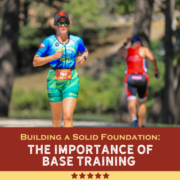Building a Solid Foundation: The Importance of Base Training for Triathletes
Base training lays the groundwork for success in triathlons by building endurance, strength, and resilience. As triathletes, we understand the importance of establishing a solid foundation to support our performance on race day. In this blog post, we’ll explore the significance of base training and provide a sample workout to help you kickstart your training journey for the Kerrville Triathlon.
Why Base Training Matters:
Base training forms the backbone of a triathlete’s training program, focusing on developing aerobic fitness and muscular endurance. By gradually increasing training volume and intensity over an extended period, base training enhances cardiovascular efficiency, improves muscular strength, and prepares the body for the rigors of higher-intensity workouts later in the season. Additionally, base training promotes injury prevention, allows for adequate recovery, and sets the stage for peak performance during race season.
Sample Base Training Workout:
(This is a sample workout, please adjust based on your skill level and training progress.)
Warm-up (5-10 minutes):
- Start with a brisk 5-minute jog or bike ride to get your blood flowing and warm up your muscles.
- Follow it up with some dynamic stretches like leg swings, arm circles, and torso twists for 5 minutes to improve flexibility and range of motion.
Main Set (30 minutes):
- Begin with a 20-minute moderate-paced run or bike ride. Maintain a comfortable pace that allows you to breathe steadily. Focus on building endurance without pushing too hard.
- Follow it with a 5-minute tempo effort, where you increase the intensity to a moderate level. Push yourself a bit, but make sure you can still maintain controlled breathing.
- Finish with a 5-minute easy recovery period. Slow down to a comfortable pace, allowing your heart rate to lower and your muscles to relax.
Cool-down (5-10 minutes):
- Spend 5-10 minutes on static stretches targeting major muscle groups. Hold each stretch for 15-30 seconds, focusing on breathing deeply and relaxing into the stretch.
Tips for Success:
- Progress Gradually: Start with manageable training volumes and gradually increase duration and intensity over time. Listen to your body and adjust your training as needed to avoid overtraining and injury.
- Stay Consistent: Consistency is key to building aerobic fitness and muscular endurance. Aim to complete base training workouts regularly, even if it means shorter sessions on busy days.
- Include Variety: Incorporate a mix of running, cycling, and swimming into your base training to target different muscle groups and prevent boredom. Cross-training also helps reduce the risk of overuse injuries.
- Prioritize Recovery: Give your body adequate time to rest and recover between workouts. Incorporate rest days, active recovery sessions, and proper nutrition to support muscle repair and adaptation.
By following a structured training program and incorporating key workouts like the sample session provided, you can build aerobic fitness, improve muscular endurance, and set yourself up for a successful season of racing. Remember to listen to your body, stay consistent, and prioritize recovery to maximize the benefits of base training. With dedication and perseverance, you’ll be well-prepared to tackle the challenges of the Kerrville Triathlon and achieve your goals on race day.



